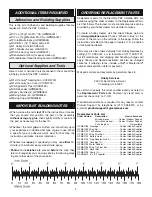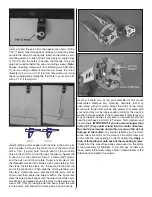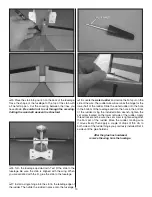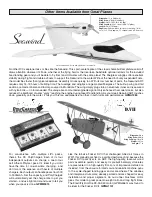
16
Different
voltages
PARALLEL
adapter
11.1V (3-Cell)
3200mAh
7.4V (2-Cell)
3200mAh
NO!!!
NEVER
connect battery packs with different voltages in
parallel. Otherwise, the batteries will try to “equalize” with the
larger one trying to “charge” the smaller one, thus causing
heat and likely a fi re.
Different
capacities
11.1V (3-Cell)
3200mAh
NO!!!
11.1V (3-Cell)
1250mAh
Also,
NEVER
connect battery packs with different capacities
in parallel.
Set the Control Throws
Use a Great Planes AccuThrow (or a ruler) to accurately
measure and set the control throw of each control surface as
indicated in the chart that follows. If your radio does not have
dual rates, we recommend setting the throws at the low rate
setting. NOTE: The throws are measured at the widest part
of the elevators, rudder and ailerons.
These are the recommended control surface throws:
High Rate
Low Rate
ELEVATOR:
1/2" [13mm] up
5/16" [8mm] up
1/2" [13mm] down
5/16" [8mm] down
RUDDER:
3/4" [19mm] left
3/8" [10mm] left
3/4" [19mm] right
3/8" [10mm] right
AILERONS:
3/8" [10mm] up
1/4" [6mm] up
3/8" [10mm] down
1/4" [6mm] down
IMPORTANT:
The PBY Catalina has been
extensively
fl own and tested to arrive at the throws at which it fl ies best.
Flying your model at these throws will provide you with the
greatest chance for successful fi rst fl ights. If, after you have
become accustomed to the way the PBY Catalina fl ies, you
would like to change the throws to suit your taste, that is
fi ne. However, too much control throw could make the model
diffi cult to control, so remember, “more is not always better.”
Balance the Model (C.G.)
More than any other factor, the
C.G.
(balance point)
can have the
greatest
effect on how a model fl ies, and
may determine whether or not your fi rst fl ight will be
successful. If you value this model and wish to enjoy it for
many fl ights,
DO NOT OVERLOOK THIS IMPORTANT
PROCEDURE.
A model that is not properly balanced will
be unstable and possibly unfl yable.
At this stage the model should be in ready-to-fl y condition
with all of the systems in place.
❏
1. Use a felt-tip pen or 1/8" [3mm]-wide tape to accurately
mark the C.G. on the bottom of the wing near the center pod
on both sides of the fuselage.
The C.G. is located 2-1/8"
[54mm] back from the leading edge of the wing.
This is where your model should balance for the fi rst
fl ights. Later, you may wish to experiment by shifting
the C.G. up to 1/8" [3mm] forward or 1/8" [3mm] back
to change the fl ying characteristics. Moving the C.G.
forward may improve the smoothness and stability, but
the model may then require more speed for takeoff and
make it more diffi cult to slow for landing. Moving the C.G.
aft makes the model more maneuverable, but could also
cause it to become too diffi cult to control. In any case,
start at the recommended balance point
and do not at
any time balance the model outside the specifi ed range.
2-1/8" [54mm]
❏
2. With the wing attached to the fuselage and all parts of
the model installed (ready to fl y), place the model on a Great
Planes CG Machine, or lift it at the balance point you marked.
❏
3. If the tail drops, the model is “tail heavy” and the battery
pack and/or receiver must be shifted forward or weight must be
added to the nose to balance. If the nose drops, the model is
“nose heavy” and the battery pack and/or receiver must be shifted
aft or weight must be added to the tail to balance. If possible,
relocate the battery pack and receiver to minimize or eliminate
any additional ballast required. Use Great Planes (GPMQ4485)
“stick on” lead. A good place to add stick-on nose weight is in the
nose of the fuselage. Begin by placing incrementally increasing
amounts of weight on the top of the fuse until the model balances.
Once you have determined the amount of weight required, it
can be permanently attached inside.





































